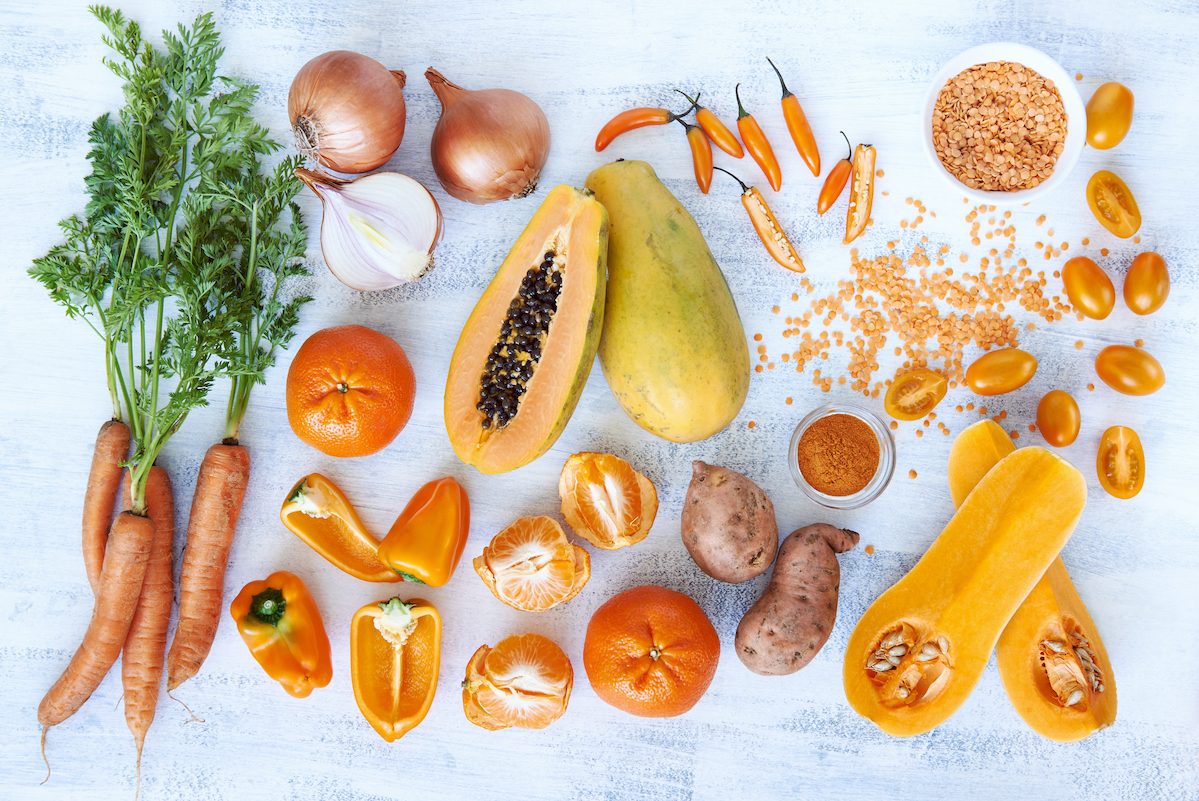With foods that are orange at the forefront, this article unveils a vibrant tapestry of health and culinary delights, inviting you on a gastronomic adventure that will tantalize your taste buds and nourish your well-being.
From the sun-kissed glow of citrus fruits to the earthy hues of root vegetables, orange foods offer a symphony of flavors and nutrients that will transform your diet into a feast for the senses.
Nutritional Benefits of Orange Foods: Foods That Are Orange
Orange-colored foods are a vibrant and nutritious addition to any diet. Their distinctive hue is often attributed to the presence of carotenoids, a group of pigments that provide numerous health benefits.One of the most well-known nutrients found in orange foods is vitamin C.
This essential vitamin is crucial for maintaining a healthy immune system. It helps protect the body against infections by supporting the production of white blood cells. Vitamin C is also a potent antioxidant, helping to neutralize free radicals that can damage cells and contribute to chronic diseases.Beyond
vitamin C, orange foods are also rich in other nutrients. Beta-carotene, another carotenoid, is converted to vitamin A in the body. Vitamin A is vital for vision, skin health, and immune function. Orange foods are also good sources of potassium, an essential mineral that helps regulate blood pressure and maintain fluid balance.The
orange-colored pigments in these foods may also possess antioxidant properties. Studies have suggested that carotenoids can help protect against oxidative stress and reduce the risk of certain chronic diseases, such as heart disease and cancer.
Types of Orange Foods

Orange foods encompass a diverse range of fruits, vegetables, and grains, each offering unique nutritional benefits. These vibrant hues often indicate high levels of carotenoids, particularly beta-carotene, which the body converts into vitamin A.
The following table provides an overview of various orange foods, their seasonality, availability, and nutritional content:
Orange Fruits
| Fruit | Season | Availability | Nutritional Content | Examples of Dishes/Recipes |
|---|---|---|---|---|
| Oranges | Winter-Spring | Year-round | Vitamin C, potassium, fiber | Orange juice, orange zest, fruit salads |
| Apricots | Summer | Seasonal | Vitamin A, potassium, fiber | Apricot jam, dried apricots, apricot pies |
| Peaches | Summer | Seasonal | Vitamin C, potassium, fiber | Peach cobbler, peach salsa, grilled peaches |
| Mangoes | Summer | Seasonal | Vitamin C, vitamin A, fiber | Mango smoothies, mango chutney, mango salsa |
Orange Vegetables
| Vegetable | Season | Availability | Nutritional Content | Examples of Dishes/Recipes |
|---|---|---|---|---|
| Carrots | Fall-Winter | Year-round | Vitamin A, potassium, fiber | Carrot juice, carrot soup, roasted carrots |
| Sweet Potatoes | Fall-Winter | Year-round | Vitamin A, potassium, fiber | Mashed sweet potatoes, sweet potato fries, sweet potato casserole |
| Pumpkin | Fall | Seasonal | Vitamin A, potassium, fiber | Pumpkin pie, pumpkin soup, roasted pumpkin |
| Butternut Squash | Fall-Winter | Seasonal | Vitamin A, potassium, fiber | Butternut squash soup, roasted butternut squash, butternut squash ravioli |
Orange Grains
| Grain | Season | Availability | Nutritional Content | Examples of Dishes/Recipes |
|---|---|---|---|---|
| Corn | Summer-Fall | Seasonal | Vitamin A, potassium, fiber | Corn on the cob, cornbread, corn tortillas |
| Quinoa | Year-round | Year-round | Protein, fiber, iron | Quinoa salad, quinoa soup, quinoa pilaf |
| Amaranth | Summer-Fall | Seasonal | Protein, fiber, iron | Amaranth porridge, amaranth bread, amaranth granola |
| Sorghum | Summer-Fall | Seasonal | Protein, fiber, iron | Sorghum flour tortillas, sorghum porridge, sorghum bread |
Culinary Uses of Orange Foods

Orange foods offer a vibrant palette to enhance the visual appeal and flavor of dishes. Their natural pigments add a cheerful hue, while their distinct flavors complement a wide range of culinary creations.
Enhancing Visual Appeal and Flavor
Orange foods create a striking contrast on plates, making dishes visually appealing. Their bright color attracts attention and stimulates the appetite. Moreover, orange foods impart a unique flavor to dishes, ranging from sweet and tangy to earthy and bitter. The sweetness of carrots, for instance, balances the bitterness of leafy greens, while the tangy flavor of oranges complements seafood dishes.
Natural Food Coloring Agents
Orange foods serve as natural food coloring agents, adding vibrant hues to dishes without the use of artificial additives. The pigments in carrots, pumpkin, and sweet potatoes can be extracted and used to color sauces, soups, and baked goods. These natural colors not only enhance the visual appeal of dishes but also provide additional nutrients.
Preserving Color and Nutrients
To preserve the vibrant color and nutrients of orange foods, certain cooking techniques should be employed. Steaming or roasting vegetables helps retain their color and texture, while blanching them in boiling water for a short period followed by immediate cooling in ice water prevents nutrient loss.
Additionally, using citrus juices or vinegar in marinades or sauces can help maintain the color of orange foods.
Health Benefits of Incorporating Orange Foods into Diet

Incorporating orange foods into your diet can provide numerous health benefits. Research suggests that consuming these foods may help reduce inflammation, improve heart health, and promote eye health.
Role in Reducing Inflammation
Orange foods contain antioxidants, such as carotenoids and flavonoids, which have anti-inflammatory properties. Studies have shown that consuming these foods may help reduce inflammation throughout the body, potentially lowering the risk of chronic diseases such as heart disease and cancer.
Benefits for Heart Health
Orange foods are rich in fiber, which helps lower cholesterol levels and improve blood flow. They also contain potassium, which helps regulate blood pressure. Additionally, the antioxidants in these foods may help protect against heart disease by reducing oxidative stress and improving endothelial function.
Promoting Eye Health
Orange foods are excellent sources of vitamin A, which is essential for eye health. Vitamin A helps protect the cornea and retina from damage, and it may also help prevent age-related macular degeneration (AMD).
Tips for Incorporating Orange Foods into Diet, Foods that are orange
- Add orange fruits to your breakfast cereal or oatmeal.
- Snack on orange vegetables like carrots, sweet potatoes, or bell peppers.
- Use orange-colored spices, such as turmeric or paprika, in your cooking.
- Make orange-flavored smoothies or juices.
- Incorporate orange fruits into salads, desserts, or baked goods.
General Inquiries
What are the nutritional benefits of orange foods?
Orange foods are rich in vitamin C, beta-carotene, potassium, and antioxidants, which contribute to immune function, heart health, and eye health.
What are some examples of orange fruits and vegetables?
Orange fruits include oranges, grapefruits, tangerines, and mangoes. Orange vegetables include carrots, sweet potatoes, pumpkins, and bell peppers.
How can I incorporate more orange foods into my diet?
Add orange fruits to your breakfast smoothies, salads, and desserts. Roast orange vegetables as a side dish or incorporate them into soups and stews.
